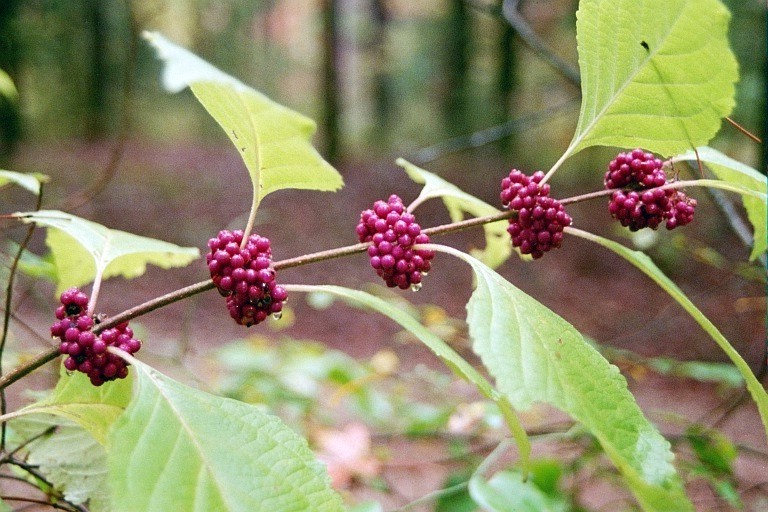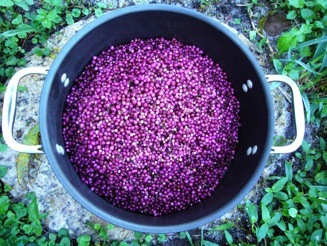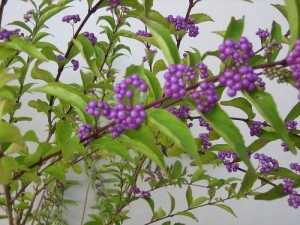Beautyberry: Callicarpa Americana
The Beautyberry is squirrel’s version of take out.
Squirrels will often break off a branch a foot or two long and carry it to an oak tree penthouse to enjoy. Mockingbirds and other birds are also exceptionally fond of the Beauty Berry. Humans are not as enthusiastic.
“Insipid” is the word usually used to describe its gustatory qualities. The truth is the berries of the Beauty Berry, or Beautyberry (Callicarpa americana, (kar-lee-KAR-pa a-mair-ee-KAY-na) while an attractive magenta, are mealy and almost flavorless. Their only immediate palate character is a little texture from a tiny seed. But, this is not to say the Beautyberry– also called the Beautybush — is worthless to man nor beast. While this writer knows of no nutritional analysis of the Beautyberry, it might have similar antioxidant and vitamin properties as other colored, edible fruit. Many web sites warn not to eat the berries, and some call them poisonous. They are not poisonous but I suppose if one is going to make a mistake it is better to say something is poisonous when it is not than edible when it is poisonous. And for the record, worldwide there are about 140 different species of Callicarpa. The leaves of this one, incidentally, make an excellent fish poison for stunning them.
Blooming pink in spring and fall, the Beautyberry has fruit clustered along the stem. The berries are slightly astringent and best eaten raw only a few at a time. Where Beautyberries excels is in making jelly. Beautyberry jelly is exceptionally good. (See recipe below.) Perhaps drying or cooking eliminates any astringency. I make Beautyberry jelly nearly every weekend it is in season as well as Pyracantha jelly (see my blog Firethorn and Santa Claus.)
Dr. Julia Morton, a famed research professor of biology at the University of Miami said this about the Beauty Berry in her book ‘Wild Plants for Survival in South Florida:” “The rank odor of the plant makes nibbling of [berry] bunches on the stem unpleasant.”
Her point was well taken: There are three chemicals in the leaves scientists are trying to replicate for mosquito repellent. They may be as effective as DEET, according to researchers with the USDA. The chemicals, particularly one called callicarpenal, showed significant bite-deterring activity against the yellow-fever mosquito and the mosquito that spreads malaria. Callicarpenal and other compounds isolated from the plant also repelled fire ants and ticks.
Native Indians had many uses for the Beautyberry, among them: A decoction of the root bark as a diuretic; the leaves for dropsy; a tea from the roots for dysentery and stomach aches; a tea made from the roots and berries for colic; and, the leaves and roots in sweat baths for the treatment of malaria, rheumatism and fevers. This author can only speak to the use of berries in jelly, and leaves as an external mosquito repellent. However, a study published 6 Feb 2007 Journal of Natural Products suggests the C. Americana has anti-cancer potential.
A fairly common Beautyberry that is an ornamental is the Callicarpa japonica. It is easy to identify from the American Beautyberry because its fruit are on long stems away from the main branch. American Beautyberries wrap around the main stem. More so, the C. japonica is long branched, slim, skinny-leafed and weeping, the C. americana is not. While there are no reports of edibility of the C. japonica’s berries that I know of (in English) the leaves are dried and used to make a tea. I do know of one person, however, who tells me she makes jelly out of C. japonica berries. There are also a few other Asian Callicarpas that have edible or medicinal parts. Callicarpa dichotoma berries are too bitter to consume.
The Beautyberry is a cousin of the smelly Lantana and the Oaxaca Lemon Verbena, which I also have in my yard. I got the Oaxaca from a Greek friend of mine who got it from a Hispanic neighbor. How this supposedly exceptionally rare plant got from one particular isolated spot in southern Mexico to Central Florida I do not know. It doesn’t even have an established common name, but it makes a nice lemon-flavored herbal tea. (See my article on Oaxaca lemon verbena.)
The following jelly recipe is from “Florida’s Incredible Wild Edibles” by Richard Deuerling and Peggy Lantz. The book is for sale on Amazon. Many years ago I used to wander through the Florida landscape with Dick and Peggy and others on outings with the Native Plant Society. They taught me a lot. The only problem with going into the wilds with such folks is it takes about an hour to go a hundred feet because there is so much to be said about the plants one knows, and debates, usually over some unidentifiable “dirty little composite.” Here is a link to their book: http://www.amazon.com/Floridas-Incredible-Edibles-Richard-Deuerling/dp/188525802X
Beautyberry Jelly
1 ½ qts. of Beautyberries, washed and clean of green stems and leaves. Cover with 2 qts. water.Boil 20 minutes and strain to make infusion. Use 3 cups of the infusion, bring to boil, add 1 envelope Sure-Jell and 4 ½ cups sugar. Bring to second boiland boil 2 minutes. Remove from heat and let stand until foam forms. Skim off foam, pour into sterilized jars, cap.
UPDATE: One of my students, Fred, does a lot of foraging and has lived his life in mosquito-ladened Florida. He reports: [Beautyberry’s] “jelly is awesome but I really love the beautyberry for its insect repellent properties. After learning about this from a Green Deane class and being an avid forager myself I decided to use the beautyberry as a bug repellent so it wouldn’t slow down my summer foraging (Florida summer mosquitoes can be horrible). I pretty much chopped up a plant(leaves and stems) and boiled it in a pot and let it cool and strained the brown liquid into my blender, about 1 1/2 cups. In a separate pot I warmed some organic neem oil (1 cup) with 1 ounce of beeswax until melted. Then you turn the blender on and pour in the oil mixture very slowly and it becomes a cream. I have to say hands down the best insect repellent ever! Because its a creme on july/august days one application is all you need for the entire day even when your sweating.”
Green Deane’s “Itemized” Plant Profile
IDENTIFICATION: A small, deciduous shrubs 1 to 2 m in height, leaves opposite, elliptical to ovate, large, with saw-toothed edges. Flowers cluster around stem, funnel-shaped with four clefs. Fruit magenta 2 to 4 seeds, White fruited ones are an escaped cultivar and edibility is unknown.
TIME OF YEAR: Spring and fall in Florida, late summer to fall in northern climes
ENVIRONMENT: Dry,open woods, moist woods, thickets and hammocks, adapted to climates with hot, humid summers and moderate winters
METHOD OF PREPARATION: A few berries can be eaten raw, depending upon your agreeing with the flavor, otherwise makes a great jelly. The berries can be used to make a tea with antioxidants.
HERB BLURB
Native American Indians used the roots and leaves to make a tea to treat fever, dysentery, malaria and rheumatism




